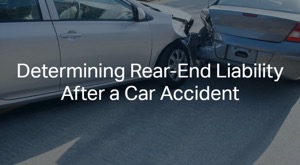
While no one expects that they will be involved in a rear-end collision, the reality is that these accidents are not uncommon. Rear-end collisions regularly occur at intersections, in stop-and-go traffic, when vehicles are making turns, and in various other situations. You may have heard that fault for these incidents always falls onto the driver whose vehicle slams into the rear of another. However, that is not necessarily the case. As with any car accident, determining liability can be challenging and is a vital part of deciding how compensation is awarded.
If you have been involved in a rear-end car accident, contact a Chicago car accident lawyer today at Seidman, Margulis & Fairman, LLP today.
Why is the Rear Car Often At-Fault?
The reason you may have heard that the vehicle that rear-ends another vehicle is usually at fault is because that is often the case. Most people are taught early in their driving career that they need to leave enough space between their vehicle and the vehicle in front of them to account for any unforeseen circumstances that could lead to an accident.
For example, if a vehicle traveling in front of you slams on their brakes, you should have left enough space between your vehicle and theirs to safely slow your vehicle or maneuver out of the way before a collision occurs.
Why Would the Rear Driver not be At-Fault?
There are various circumstances that can occur on the roadway that would result in the rear driver in a rear-end collision not being at fault. Liability for a rear-end collision is not automatic. The lead vehicle could also be liable for any situations if they were negligent or operating recklessly. This could include the front driver:
- Reversing into the rear car
- Operating while under the influence of alcohol or drugs
- Intentionally trying to get hit (brake checking)
- Operating with broken brake lights or broken taillights
Just because a person is rear-ended does not mean they are absolved of blame. All drivers must use reasonable care when operating their vehicles to ensure that they uphold their duty to others on the roadway around them.
Determining Liability in these Collisions
One of the most important factors in securing compensation in the aftermath of a rear-end collision is determining liability. If you were operating the rear vehicle of a rear-end collision, and you believe that the front driver was responsible for the crash, it may be necessary to secure an attorney to help determine liability for the incident.
There are various types of evidence that can be used to prove the liability of drivers involved in these collisions. First, it is important to ensure that law enforcement officials come to the scene and conduct a preliminary investigation. Often, a police officer will note in their report which party they believe to be responsible for the incident.
However, police reports are often incomplete, inclusive, or do not contain all of the evidence needed to prove liability. An attorney can also:
- Obtain photo or video surveillance from nearby cameras to help prove liability
- Speak to any eyewitnesses to the crash in an effort to determine the events leading up to the crash
- Fully analyze any accident reports to ensure that the evidence matches what the police officer said about the incident
 North Chicago & St. Louis Injury Updates
North Chicago & St. Louis Injury Updates

